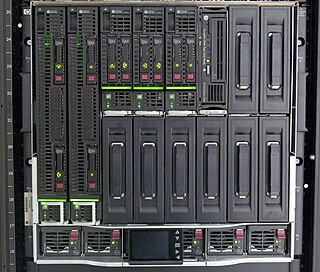
OpenVMS, often referred to as just VMS, is a multi-user, multiprocessing and virtual memory-based operating system. It is designed to support time-sharing, batch processing, transaction processing and workstation applications. Customers using OpenVMS include banks and financial services, hospitals and healthcare, telecommunications operators, network information services, and industrial manufacturers. During the 1990s and 2000s, there were approximately half a million VMS systems in operation worldwide.

HP Autonomy, previously Autonomy Corporation PLC, was an enterprise software company which was merged with Micro Focus in 2017 and OpenText in 2023. It was founded in Cambridge, United Kingdom in 1996.
NonStop is a series of server computers introduced to market in 1976 by Tandem Computers Inc., beginning with the NonStop product line. It was followed by the Tandem Integrity NonStop line of lock-step fault-tolerant computers, now defunct. The original NonStop product line is currently offered by Hewlett Packard Enterprise since Hewlett-Packard Company's split in 2015. Because NonStop systems are based on an integrated hardware/software stack, Tandem and later HPE also developed the NonStop OS operating system for them.
HPE Integrity Servers is a series of server computers produced by Hewlett Packard Enterprise since 2003, based on the Itanium processor. The Integrity brand name was inherited by HP from Tandem Computers via Compaq.
The Intelligent Platform Management Interface (IPMI) is a set of computer interface specifications for an autonomous computer subsystem that provides management and monitoring capabilities independently of the host system's CPU, firmware and operating system. IPMI defines a set of interfaces used by system administrators for out-of-band management of computer systems and monitoring of their operation. For example, IPMI provides a way to manage a computer that may be powered off or otherwise unresponsive by using a network connection to the hardware rather than to an operating system or login shell. Another use case may be installing a custom operating system remotely. Without IPMI, installing a custom operating system may require an administrator to be physically present near the computer, insert a DVD or a USB flash drive containing the OS installer and complete the installation process using a monitor and a keyboard. Using IPMI, an administrator can mount an ISO image, simulate an installer DVD, and perform the installation remotely.
Ilo, ILO or variations may refer to:
The IBM Remote Supervisor Adapter is a full-length ISA or PCI adapter produced by the IBM corporation.
Integrity Virtual Machines is a hypervisor from Hewlett Packard Enterprise for HPE Integrity Servers running HP-UX. It is part of HP's Virtual Server Environment suite, and is optimized for server use.

ProLiant is a brand of server computers that was originally developed and marketed by Compaq, Hewlett-Packard (HP), and currently marketed by Hewlett Packard Enterprise (HPE). ProLiant servers were first introduced by Compaq in 1993, succeeding their SystemPro line of servers in the high-end space.

Intel Active Management Technology (AMT) is hardware and firmware for remote out-of-band management of select business computers, running on the Intel Management Engine, a microprocessor subsystem not exposed to the user, intended for monitoring, maintenance, updating, and repairing systems. Out-of-band (OOB) or hardware-based management is different from software-based management and software management agents.
HPE Service Activator is a service provisioning and activation software platform from Hewlett Packard Enterprise. Once installed and integrated with a Customer Service Provider's (CSP) environment, HPESA automates the processes inherent in the creation and activation of new telecommunications services. It is not specific to any network or service type and can apply across fixed, mobile, or internet environments. HPESA software is activation-centric, but engages the entire fulfillment stack as defined by the TeleManagement Forum's Business Process Framework (eTOM) framework, including order management, resource inventory and service activation.

BladeSystem is a line of blade server machines from Hewlett Packard Enterprise that was introduced in June 2006.
A headless computer is a computer system or device that has been configured to operate without a monitor, keyboard, and mouse. A headless system is typically controlled over a network connection, although some headless system devices require a serial connection to be made over RS-232 for administration of the device. Headless operation of a server is typically employed to reduce operating costs.
HP ConvergedSystem is a portfolio of system-based products from Hewlett-Packard (HP) that integrates preconfigured IT components into systems for virtualization, cloud computing, big data, collaboration, converged management, and client virtualization. Composed of servers, storage, networking, and integrated software and services, the systems are designed to address the cost and complexity of data center operations and maintenance by pulling the IT components together into a single resource pool so they are easier to manage and faster to deploy. Where previously it would take three to six months from the time of order to get a system up and running, it now reportedly takes as few as 20 days with the HP ConvergedSystem.
Micro Focus Service Manager is one of the applications acquired by Micro Focus when it purchased part of Hewlett-Packard Enterprise Software (HPES) in 2017. Before 2017, it was owned by HP when it purchased Peregrine Systems in 2005. The application was originally known as PNMS. After releasing the first version of PNMS, Peregrine Systems eventually added functionality such as Request Management, Call Management, and Change Management and rebranded the application as Peregrine ServiceCenter.

The Intel Management Engine (ME), also known as the Intel Manageability Engine, is an autonomous subsystem that has been incorporated in virtually all of Intel's processor chipsets since 2008. It is located in the Platform Controller Hub of modern Intel motherboards.

The Hewlett Packard Enterprise Company (HPE) is an American multinational information technology company based in Spring, Texas.
The Redfish standard is a suite of specifications that deliver an industry standard protocol providing a RESTful interface for the management of servers, storage, networking, and converged infrastructure.

NetServer was a line of x86-based server and workstation computers sold by Hewlett-Packard (HP) from 1993 to 2002. It was Hewlett-Packard's first entry in the commodity local area networking (LAN) market.







